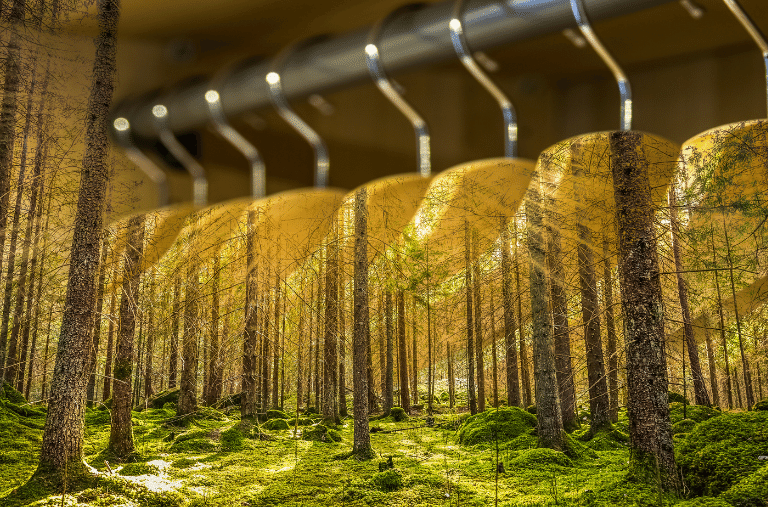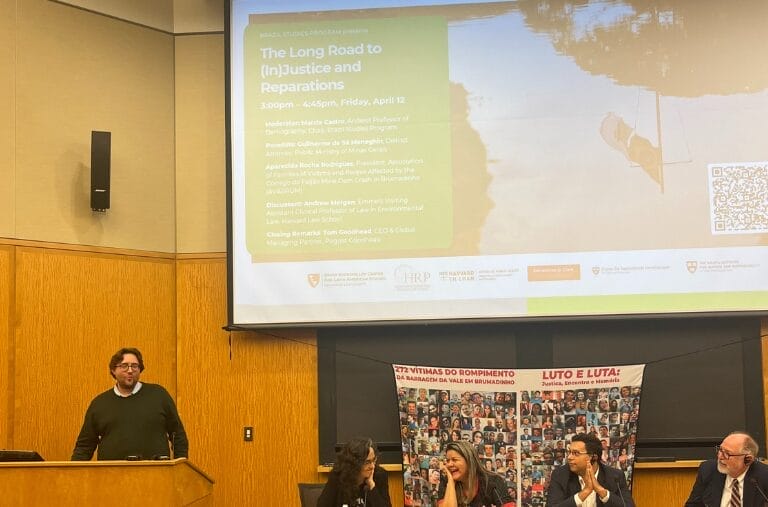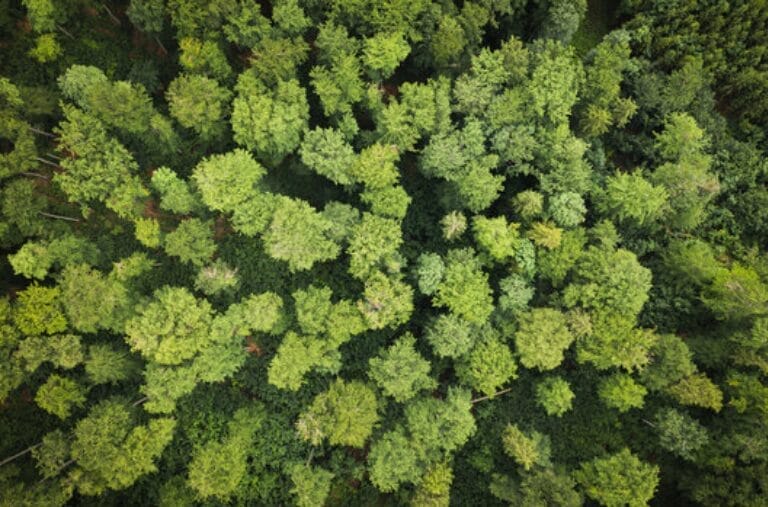Post-festive season, there is fresh motivation to set goals for the year ahead. It is increasingly in vogue to focus on the environmental impact of our lifestyle choices: signing up to Veganuary, switching to keep cups, reducing air travel, etc.
One of the areas where there is potential room for improvement is our wardrobes. The clothes, bags, and shoes we buy and wear can represent one of the most significant – and most harmful – ways we impact the planet.
The Beef with Leather
A recent report by Stand.earth draws attention to the environmental impact of a specific component of our wardrobes: leather.
The report focuses on the fashion industry’s links to deforestation in the Brazilian Amazon, which is fuelled by the cattle industry.[1]
When we think of cattle farming, the primary consumer product we tend to picture is beef.[2] Unfortunately, the connection between cattle and the fashion industry in the form of leather goods has been given less attention.
Alongside beef products, leather is the primary driver of the global cattle industry. 80% of the leather derived from cattle farming in the Brazilian Amazon is exported, used by global fashion brands to make consumer products that appear on catwalks and shop shelves around the world.[3]
The Stand.earth report indicates that over 100 brands which manufacture leather goods may be implicated in the deforestation caused by this cattle farming. However, high-end bags and shoes have largely escaped the censure that beef consumption has provoked in recent years, and there has not been the same consumer-driven shift to more ethical and sustainable alternatives.[4]
According to the Mighty Earth organisation, multinational companies involved in the cattle industry in Brazil[5] have been implicated in over 200,000 acres of deforestation. The fashion brands sourcing their leather directly or indirectly from these multinational companies are household names and, in recent months, media outlets have published numerous articles on the alleged links between these brands and deforestation.[6]
Spotlight on Deforestation
Deforestation is a global issue, with approximately one billion acres of the world’s forests destroyed since 1990, according to the UN[7], and 48% of the total forest area destroyed between 2001 and 2015 was concentrated in Brazil.[8]
Under the leadership of President Jair Bolsonaro, from 2011 to 2020, the Brazilian government reported a loss of 16.5 million acres of forests in the Brazilian Amazon[9] and annual deforestation rates almost doubled during this period.
In 2021, the Amazon emitted more carbon dioxide than it absorbed for the first time in recorded history.[10] Based on Stand.earth’s studies, the annual CO2 emissions due to this deforestation in the Brazilian Amazon are equivalent to emissions from a year’s worth of flights globally.[11]
The Stand.earth report highlights that much of this deforestation allegedly linked to well-known fashion brands may have been illegal. According to their studies, up to 81% of the deforestation that took place between March 2019 and March 2021 was unlawful.
While arguably all deforestation is unethical, illegal deforestation refers to the unlawful grazing of cattle in protected areas such as indigenous territories.[12]
These territories and the people who make their homes there have been the collateral damage of the profit-driven destruction of the Amazonian rainforest.
Deforestation and the Fashion Industry
It is difficult to ascertain the exact scale of the issue in the supply chains of the fashion brands implicated in Stand.earth’s report. This is because the leading environmental certification for the leather manufacturing industry, the Leather Working Group (LWG), is unable to trace companies’ products back to their indirect or original suppliers, as this data does not exist.[13]
Some companies have recognised the need to curb deforestation by voluntarily committing to reducing their impact on the world’s forests. However, there is a stark disparity between stated ambitions and reality. The problem is that there is no independent monitoring of such pledges, and companies’ motivation to deviate from reliably profitable business models is slim.
Addressing the issue – can the law help?
Recognition of the paramount importance of the planet’s tree cover in combatting the climate emergency has pushed deforestation up the global agenda in recent months.
The issue was centre stage at COP26, with leaders reaching an agreement on a deal intended to end and reverse deforestation globally.[14]
In November 2021, the European Commission published a proposal for a Regulation to minimise EU-driven deforestation and forests degradation,[15] which aims to impose stricter regulations within the EU market on goods associated with deforestation, including leather.[16] While such initiatives represent a shift in the right direction, the impact of such political expressions of intent is unlikely to be felt in the immediate future.
As noted in a previous article on our blog, claims for fraud and misrepresentation based on environment-related disinformation are being pursued in multiple jurisdictions.
Such legal action against private companies can have both a direct role in addressing greenwashing, as well as a soft law impact in changing both industry norms and consumer expectations.
This could be applied to statements by the corporates behind fashion brands to achieve accountability where pledges blatantly contradict the reality of efforts to achieve sustainability in supply chains – for example, when such companies are demonstrably implicated in deforestation.
Another legal mechanism for holding companies to account is arbitration. Arbitration was successfully employed in the context of the fashion industry through the Bangladesh Accord, an agreement on factory safety standards entered into by major brands following the Rana Plaza collapse (see discussion of the Accord in this previous article on our blog).[17]
Similarities between the forestry industry (upon which the cattle industry depends) and the fashion industry may make a Bangladesh Accord-type approach viable.[18] Such an agreement could include binding commitments by companies to eliminate deforestation in supply chains, with provisions for enforceable arbitration if disputes arise.
This approach presents practical challenges (for example, who would be the appropriate party to enforce the agreement in the absence of a coordinated representative body, a role played by workers’ union federations in the Bangladesh Accord) but, with the right engagement from all stakeholders, a Bangladesh Accord-type approach has the potential to be effective.
Your wardrobe, your choice
Despite the challenges in holding companies to account, there is increasing momentum to address the uglier side of the fashion industry. Deforestation is by no means the only ethical concern: human rights abuses in manufactories,[19] modern slavery in distribution warehouses,[20] fast fashion, and waste due to overproduction[21] are just some of the issues which have a severe impact on the environment as well as people.
When it comes to new year’s resolutions this year, the best place to start may be your wardrobe.
References [1] And of deforestation of tropical forests globally - https://insights.trase.earth/yearbook/contexts/brazil-beef/ [2] For example, British supermarkets recently agreed to stop selling Brazilian beef products linked to deforestation. https://www.theguardian.com/environment/2021/dec/16/supermarkets-drop-brazilian-beef-products-linked-to-deforestation [3] https://www.regnskog.no/uploads/documents/Driving_Deforestation_16_June-compressed.pdf [4] Although they do exist: for example, vegan materials like PVB (polyvinyl butyral), made of 100% recycled windshield glass resin, or plant-based leather, drawn from natural sources like fruit skin fibres, such as pineapple leaves, mushrooms, kombucha cultures, and even agricultural waste—all of which are biodegradable and easily recycled (https://www.surfacemag.com/articles/vegan-leather-sustainable/). [5] https://www.mightyearth.org/soy-and-cattle-tracker/ [6] See for examples https://www.theguardian.com/us-news/2021/nov/29/fashion-industry-amazon-rainforest-deforestation?fbclid=IwAR2jiwEGDIK2kqirAhK51BXYSbX0i4mRpPtfgt8rKUByuWub94PF4XaWYu0; https://thefifthestate.com.au/home-and-lifestyle/consumers/your-choice-of-fashion-brands-may-cause-deforestation/; https://www.forbesindia.com/article/lifes/how-major-fashion-brands-could-be-contributing-to-amazon-deforestation/71977/1 [7] https://www.fao.org/state-of-forests/en/ [8] https://research.wri.org/gfr/forest-extent-indicators/deforestation-agriculture [9] http://terrabrasilis.dpi.inpe.br/app/dashboard/deforestation/biomes/amazon/increments [10]https://www.nytimes.com/2021/07/14/climate/amazon-rainforest-carbon.html; https://www.nature.com/articles/s41586-021-03629-6 [11]https://www.stand.earth/publication/forest-conservation/amazon-forest-protection/amazon-leather-supply-chain#slidedeck [12]https://www.theguardian.com/environment/2020/jul/27/revealed-new-evidence-links-brazil-meat-giant-jbs-to-amazon-deforestation; https://www.amnesty.org/en/documents/amr19/2657/2020/en/&sa=D&source=editors&ust=1641287429960999&usg=AOvVaw0V0TJMytwH8ZDPG6BDKqyW [13] See note 11 above. [14] https://www.theguardian.com/environment/2021/nov/01/biden-bolsonaro-and-xi-among-leaders-agreeing-to-end-deforestation-aoe [15] This was part of the Commission’s 2019 Communication on Stepping up EU Action to Protect and Restore the World’s Forests. [16] The proposed regulation would apply to soy, beef, palm oil, wood, cocoa and coffee and certain derived products, including leather and chocolate. [17] See https://bangladeshaccord.org/about; the original 2013 Accord here and the 2018 Transition Accord here. See also the new International Accord for Health and Safety in the Textile and Garment Industry which took effect on 1 September 2021 here. [18] https://files.essexcourt.com/wp-content/uploads/2018/09/08152804/Bangladesh-Accord-lecture.pdf p.15 [19] See for example https://www.businessoffashion.com/news/sustainability/human-rights-violations-are-increasing-in-fashions-manufacturing-hubs/; https://repository.gchumanrights.org/bitstream/handle/20.500.11825/819/Corradini.pdf?sequence=1&isAllowed=y; https://www.aljazeera.com/economy/2021/7/14/are-your-favourite-fashion-brands-using-forced-labour [20] See for example https://www.theguardian.com/business/2021/oct/22/retailers-press-for-human-rights-and-environmental-checks-on-supply-chains [21] See for example https://www.bbc.com/future/article/20200710-why-clothes-are-so-hard-to-recycle; https://www.businessinsider.com/fast-fashion-environmental-impact-pollution-emissions-waste-water-2019-10?r=US&IR=T#in-europe-fashion-companies-went-from-an-average-offering-of-two-collections-per-year-in-2000-to-five-in-2011-3









